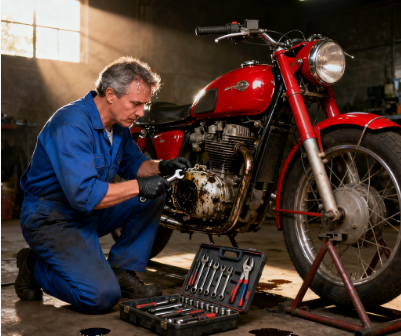How to Choose Motorcycle Bearings: A Comprehensive Guide
How to Choose Motorcycle Bearings: A Comprehensive Guide
Choosing the right bearings for your motorcycle is crucial for ensuring optimal performance, safety, and longevity. Bearings play a vital role in the smooth operation of various components, including the wheels, engine, and transmission. In this guide, we will explore the key factors to consider when selecting motorcycle bearings, helping you make an informed decision for your ride.
———————————————————————————————————————————————————————————————————————————————————————————————————————————–
1. Understand the Types of Motorcycle Bearings
a. Wheel Bearings
Wheel bearings are essential for the smooth rotation of the wheels. They support the weight of the motorcycle and allow the wheels to spin freely. Common types include:
• Ball Bearings: Suitable for lighter motorcycles and provide good speed.
• Roller Bearings: Better for heavier loads and provide enhanced durability.
b. Steering Head Bearings
These bearings allow the front fork to turn smoothly. They come in two main types:
• Caged Bearings: Easier to install and maintain.
• Tapered Roller Bearings: Offer better load distribution and are ideal for performance bikes.
2. Consider the Material
The material of the bearings significantly affects their performance and durability. Common materials include:
• Steel: Offers strength and durability but may be prone to rust if not properly maintained.
• Ceramic: Lightweight and resistant to corrosion, ceramic bearings provide lower friction but can be more expensive.
• Stainless Steel: Combines the strength of steel with corrosion resistance, making it a popular choice for various motorcycle applications.
3. Check the Bearing Size
Before purchasing bearings, it’s essential to know the correct size for your motorcycle. Refer to your motorcycle’s service manual or consult with a professional to ensure you select the right dimensions. Common measurements include:
• Inner Diameter (ID): The size of the hole in the center of the bearing.
• Outer Diameter (OD): The overall size of the bearing.
• Width: The thickness of the bearing.
4. Look for Quality and Brand Reputation
When it comes to motorcycle bearings, quality matters. Opt for reputable brands known for their reliability and performance. High-quality bearings may cost more upfront but can save you money in the long run by reducing maintenance and replacement costs. Look for:
• Reviews and Ratings: Check online reviews and ratings from other motorcycle enthusiasts.
• Warranty: A good warranty can indicate the manufacturer’s confidence in their product.
5.Consider Your Riding Style
Your riding style can influence the type of bearings you need. For example:
• Casual Riders: Standard bearings may suffice for everyday use.
• Performance Riders: Consider high-performance bearings that can withstand higher speeds and loads.
• Off-Road Riders: Look for bearings designed to handle dirt and debris, often featuring seals or shields for added protection.
Conclusion
——————————————————————————————————————————–
Choosing the right motorcycle bearings is essential for ensuring a smooth and safe ride. By understanding the types of bearings, considering the material, checking the size, looking for quality, and factoring in your riding style, you can make an informed decision that enhances your motorcycle’s performance and longevity.
For a wide selection of high-quality motorcycle bearings tailored to your needs, contact us. Let us help you find the perfect bearings to keep your motorcycle running smoothly!

